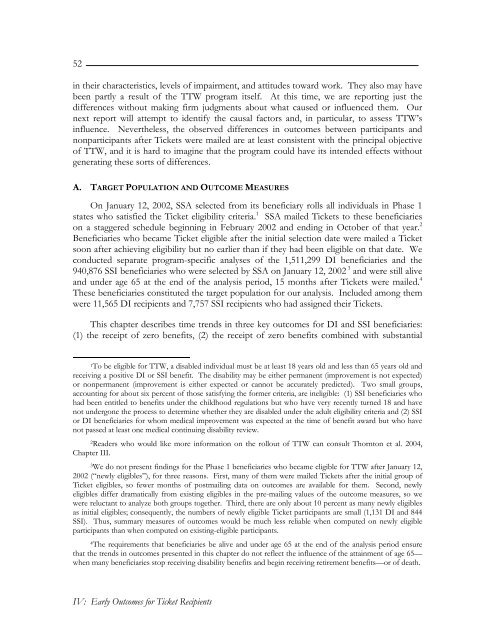Evaluation of the Ticket to Work Program, Implementation ...
Evaluation of the Ticket to Work Program, Implementation ...
Evaluation of the Ticket to Work Program, Implementation ...
You also want an ePaper? Increase the reach of your titles
YUMPU automatically turns print PDFs into web optimized ePapers that Google loves.
52in <strong>the</strong>ir characteristics, levels <strong>of</strong> impairment, and attitudes <strong>to</strong>ward work. They also may havebeen partly a result <strong>of</strong> <strong>the</strong> TTW program itself. At this time, we are reporting just <strong>the</strong>differences without making firm judgments about what caused or influenced <strong>the</strong>m. Ournext report will attempt <strong>to</strong> identify <strong>the</strong> causal fac<strong>to</strong>rs and, in particular, <strong>to</strong> assess TTW’sinfluence. Never<strong>the</strong>less, <strong>the</strong> observed differences in outcomes between participants andnonparticipants after <strong>Ticket</strong>s were mailed are at least consistent with <strong>the</strong> principal objective<strong>of</strong> TTW, and it is hard <strong>to</strong> imagine that <strong>the</strong> program could have its intended effects withoutgenerating <strong>the</strong>se sorts <strong>of</strong> differences.A. TARGET POPULATION AND OUTCOME MEASURESOn January 12, 2002, SSA selected from its beneficiary rolls all individuals in Phase 1states who satisfied <strong>the</strong> <strong>Ticket</strong> eligibility criteria. 1 SSA mailed <strong>Ticket</strong>s <strong>to</strong> <strong>the</strong>se beneficiarieson a staggered schedule beginning in February 2002 and ending in Oc<strong>to</strong>ber <strong>of</strong> that year. 2Beneficiaries who became <strong>Ticket</strong> eligible after <strong>the</strong> initial selection date were mailed a <strong>Ticket</strong>soon after achieving eligibility but no earlier than if <strong>the</strong>y had been eligible on that date. Weconducted separate program-specific analyses <strong>of</strong> <strong>the</strong> 1,511,299 DI beneficiaries and <strong>the</strong>940,876 SSI beneficiaries who were selected by SSA on January 12, 2002 3 and were still aliveand under age 65 at <strong>the</strong> end <strong>of</strong> <strong>the</strong> analysis period, 15 months after <strong>Ticket</strong>s were mailed. 4These beneficiaries constituted <strong>the</strong> target population for our analysis. Included among <strong>the</strong>mwere 11,565 DI recipients and 7,757 SSI recipients who had assigned <strong>the</strong>ir <strong>Ticket</strong>s.This chapter describes time trends in three key outcomes for DI and SSI beneficiaries:(1) <strong>the</strong> receipt <strong>of</strong> zero benefits, (2) <strong>the</strong> receipt <strong>of</strong> zero benefits combined with substantial1To be eligible for TTW, a disabled individual must be at least 18 years old and less than 65 years old andreceiving a positive DI or SSI benefit. The disability may be ei<strong>the</strong>r permanent (improvement is not expected)or nonpermanent (improvement is ei<strong>the</strong>r expected or cannot be accurately predicted). Two small groups,accounting for about six percent <strong>of</strong> those satisfying <strong>the</strong> former criteria, are ineligible: (1) SSI beneficiaries whohad been entitled <strong>to</strong> benefits under <strong>the</strong> childhood regulations but who have very recently turned 18 and havenot undergone <strong>the</strong> process <strong>to</strong> determine whe<strong>the</strong>r <strong>the</strong>y are disabled under <strong>the</strong> adult eligibility criteria and (2) SSIor DI beneficiaries for whom medical improvement was expected at <strong>the</strong> time <strong>of</strong> benefit award but who havenot passed at least one medical continuing disability review.2 Readers who would like more information on <strong>the</strong> rollout <strong>of</strong> TTW can consult Thorn<strong>to</strong>n et al. 2004,Chapter III.3 We do not present findings for <strong>the</strong> Phase 1 beneficiaries who became eligible for TTW after January 12,2002 (“newly eligibles”), for three reasons. First, many <strong>of</strong> <strong>the</strong>m were mailed <strong>Ticket</strong>s after <strong>the</strong> initial group <strong>of</strong><strong>Ticket</strong> eligibles, so fewer months <strong>of</strong> postmailing data on outcomes are available for <strong>the</strong>m. Second, newlyeligibles differ dramatically from existing eligibles in <strong>the</strong> pre-mailing values <strong>of</strong> <strong>the</strong> outcome measures, so wewere reluctant <strong>to</strong> analyze both groups <strong>to</strong>ge<strong>the</strong>r. Third, <strong>the</strong>re are only about 10 percent as many newly eligiblesas initial eligibles; consequently, <strong>the</strong> numbers <strong>of</strong> newly eligible <strong>Ticket</strong> participants are small (1,131 DI and 844SSI). Thus, summary measures <strong>of</strong> outcomes would be much less reliable when computed on newly eligibleparticipants than when computed on existing-eligible participants.4 The requirements that beneficiaries be alive and under age 65 at <strong>the</strong> end <strong>of</strong> <strong>the</strong> analysis period ensurethat <strong>the</strong> trends in outcomes presented in this chapter do not reflect <strong>the</strong> influence <strong>of</strong> <strong>the</strong> attainment <strong>of</strong> age 65—when many beneficiaries s<strong>to</strong>p receiving disability benefits and begin receiving retirement benefits—or <strong>of</strong> death.IV: Early Outcomes for <strong>Ticket</strong> Recipients
















